Follow Us:
Share
Table of Contents:
The Russian Tu 160, known by its NATO codename “Blackjack,” is a supersonic strategic bomber designed with variable-sweep wings. This advanced missile carrier was developed by the Tupolev Design Bureau in collaboration with the Kazan-Gorbunov Aircraft Production Association, located in Tatarstan.
The manufacturing of the Tupolev Tu-160 Blackjack began in 1980 and continued through 1992.
The bomber made its inaugural flight in December 1981 and officially entered service with the Ukrainian Long-Range Aviation forces in April 1987. After a brief pause in production, manufacturing resumed, and in May 2000, a new Tu-160 was delivered to the Russian Air Force. In total, 36 of these aircraft were produced, with 17 still operational in Russia today.
Nicknamed the “White Swan” due to its graceful maneuverability and distinctive anti-flash white coating, the Tupolev Tu-160 Blackjack was built for both nuclear and conventional strike missions, capable of penetrating deep into enemy territory.
Designed to perform in any weather condition, day or night, and across all latitudes, its capabilities are often compared to the American B-1B bomber.
The Tupolev Tu-160 Blackjack holds an impressive legacy, having set 44 world aviation records.
Russian Tupolev Tu-160 Blackjack Strategic Bomber
The Russian Tu 160 Blackjack is a versatile strategic bomber designed to perform a wide range of missions, from flying at low altitudes at subsonic speeds to reaching supersonic speeds of over Mach 1 at higher altitudes.
It is equipped with two internal weapons bays that can carry various mission-specific payloads, such as strategic cruise missiles, short-range guided missiles, nuclear and conventional bombs, as well as mines. Its core weaponry, consisting of short-range guided missiles and strategic cruise missiles, allows it to execute nuclear strikes on targets with predetermined coordinates.
Looking ahead, with the integration of high-precision conventional weapons, the aircraft could also be deployed against mobile or tactical targets, further expanding its operational capabilities.
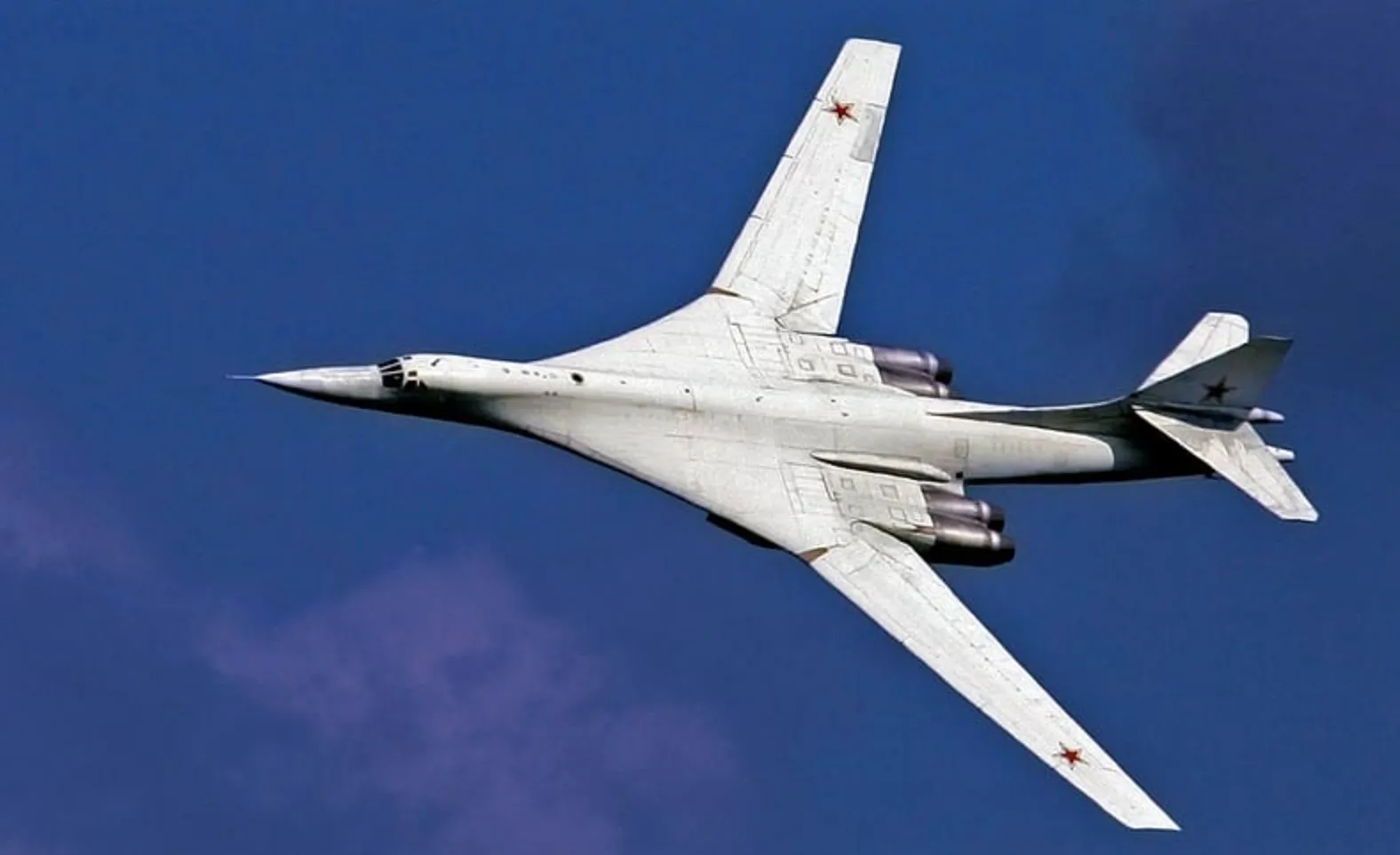
The T-160, recognized as the most formidable combat aircraft within the Soviet Air Forces, can reach speeds of 2,000 km/h, surpassing this threshold when equipped with a mission-specific payload. With an impressive climb rate of 60 to 70 meters per second, the aircraft can ascend to altitudes of up to 15,000 meters.
Additionally, it can be refueled mid-flight by IL-78 and ZMS-2 tanker planes. The refueling process employs a probe-and-drogue system, which allows for seamless air-to-air refueling during operations.
In terms of armament, the Tupolev Tu-160 Blackjack is capable of carrying up to 12 Kh-55 long-range missiles as well as Kh-15 short-range missiles. Its weapons bays are versatile, and able to accommodate various payloads, including free-fall nuclear bombs and conventional bombs weighing up to 1,500 kg. Notably, the aircraft does not have any onboard artillery systems.
Modernization
In 2002, the Russian Ministry of Defense and the Kazan Aviation Production Association (KAPO) entered into an agreement to modernize 15 Tu-160 strategic bombers.
By July 2006, the first overhauled and partially upgraded Tupolev Tu-160 Blackjack re-entered Russian service after undergoing rigorous testing. This aircraft was reported to have been equipped with the capability to deploy conventional weapons, although plans to update its avionics were not fully realized at that time.
In April 2008, the Russian Air Force received the first fully modernized Tupolev Tu-160 Blackjack capable of carrying the new long-range Kh-555 conventional cruise missile. A subsequent contract was signed for the modernization of three additional aircraft, with the total cost estimated at 3.4 billion rubles (approximately $103 million USD).
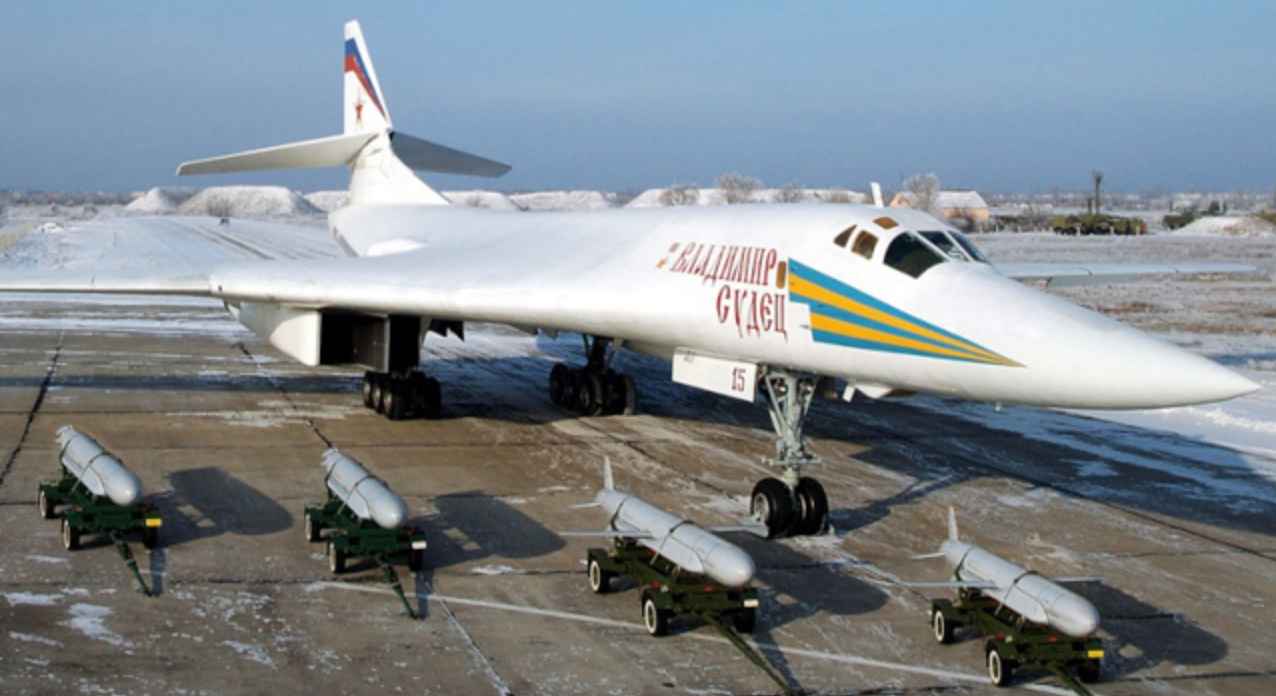
The modernization process appeared to be divided into two distinct phases. The first phase focused on extending the operational life of the aircraft and implementing some communication and navigation updates. The second phase, planned after 2016, aimed to upgrade the engines.
In November 2014, an upgraded Tupolev Tu-160 Blackjack fitted with new radar and avionics successfully completed its maiden flight, and in December of the same year, this aircraft was officially delivered to the Russian Air Force as the Tu-160M model.
Phase one of the modernization was expected to be completed by 2016, but industrial challenges indicated a possible delay until 2019 or later. The Kuznetsov Design Bureau developed the NK-32M engine, which offered improved reliability compared to its predecessor, the NK-32.
However, the company struggled to produce functioning units. Metallist Samara JSC, tasked with overhauling 26 engines under a contract awarded in 2011, had completed only four units by 2013, having not manufactured new engines for over a decade.
Financial constraints and ownership issues further complicated efforts to establish a new production line. While the company insisted it needed an annual order of at least 20 engines to maintain operations, the government was only willing to fund the production of 4 to 6 engines per year. A further improved engine underwent bench testing in 2012, with hopes that it might enter production as early as 2016.
On February 2, 2020, the modernized Tu-160M successfully completed its first test flight at the Kazan Aviation Plant, named after I. Gorbunov. Later that year, deliveries commenced, and by August 2022, five aircraft had been equipped with the new engines.
In 2023, Russian President Vladimir Putin confirmed that four Tu-160M aircraft had been delivered.
Resumed Production
At the 2013 Moscow Victory Day Parade, the Tupolev Tu-160 Blackjack made a prominent appearance, symbolizing Russia’s commitment to maintaining and modernizing its strategic bomber fleet. Back in 2008, Russia disclosed its intentions to produce a new Tu-160 bomber every one to two years, with the ultimate goal of increasing its operational fleet to at least 30 aircraft by the mid-2020s, specifically by 2025–2030.
On April 29, 2015, Russian Defense Minister Sergei Shoigu, following direct orders from President Vladimir Putin, officially declared the resumption of Tu-160 production. Fast forward to January 12, 2022, when a newly constructed Tu-160M completed its maiden low-altitude test flight, marking a significant milestone in the aircraft’s development.
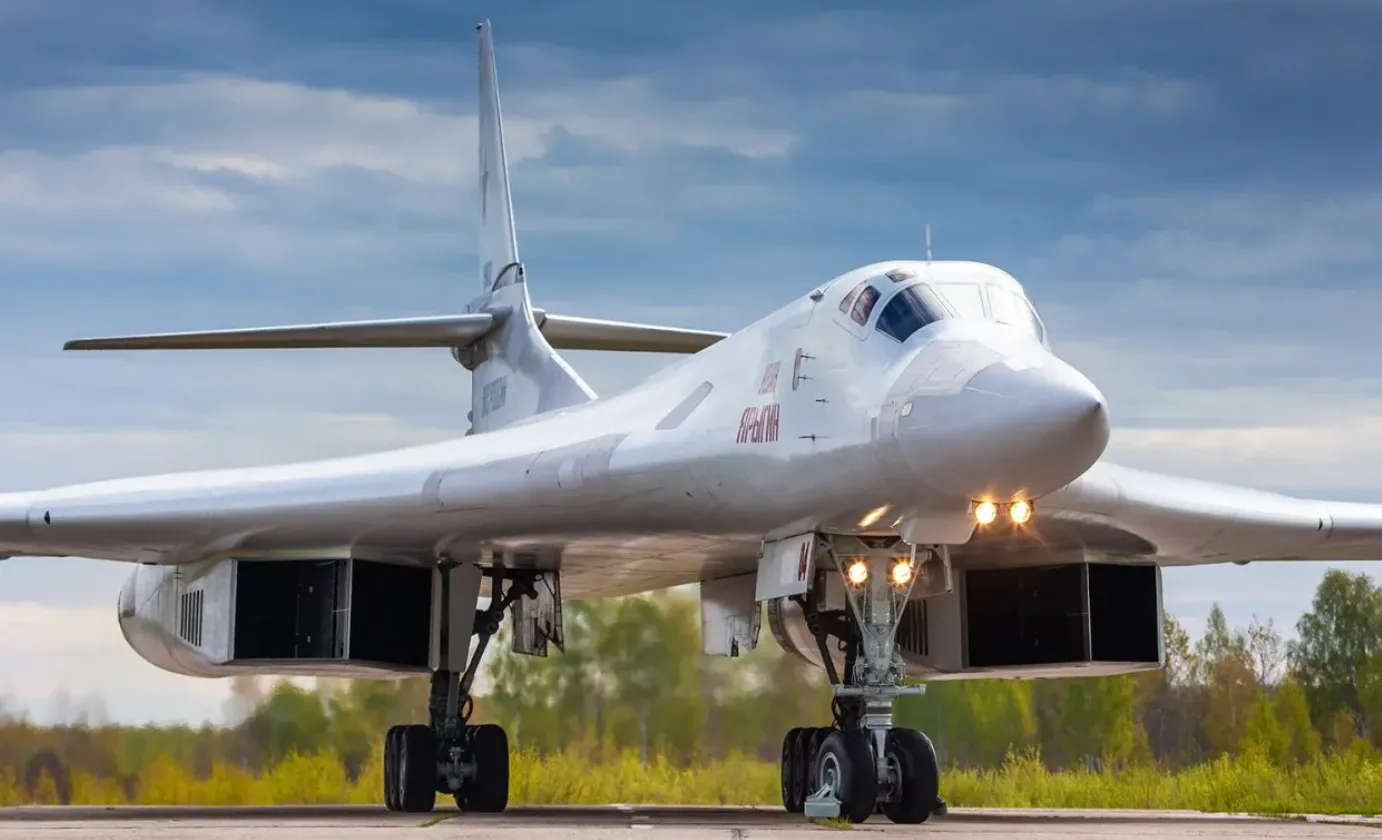
Russia planned to deliver two new Tu-160M aircraft within 2022, with production gradually ramping up to fulfill an order of 50 new aircraft. In December 2022, United Aircraft Corporation confirmed that both the second newly-built Tu-160M and the fourth upgraded Tu-160M had entered the flight testing phase.
Additionally, the first of the new aircraft had successfully passed factory testing.
As of February 21, 2024, four Tu-160M bombers had been delivered, signaling steady progress in Russia’s ambitious strategic bomber program.
Tupolev Tu-160 Blackjack Design
The bomber’s airframe boasts a unique design, where the wings and fuselage seamlessly merge into a unified, single-piece structure. This airframe is constructed around a central titanium beam, forming an all-welded torsion box for enhanced strength and durability. All primary structural components of the airframe are securely attached to this titanium beam, ensuring the bomber’s robust integrity.
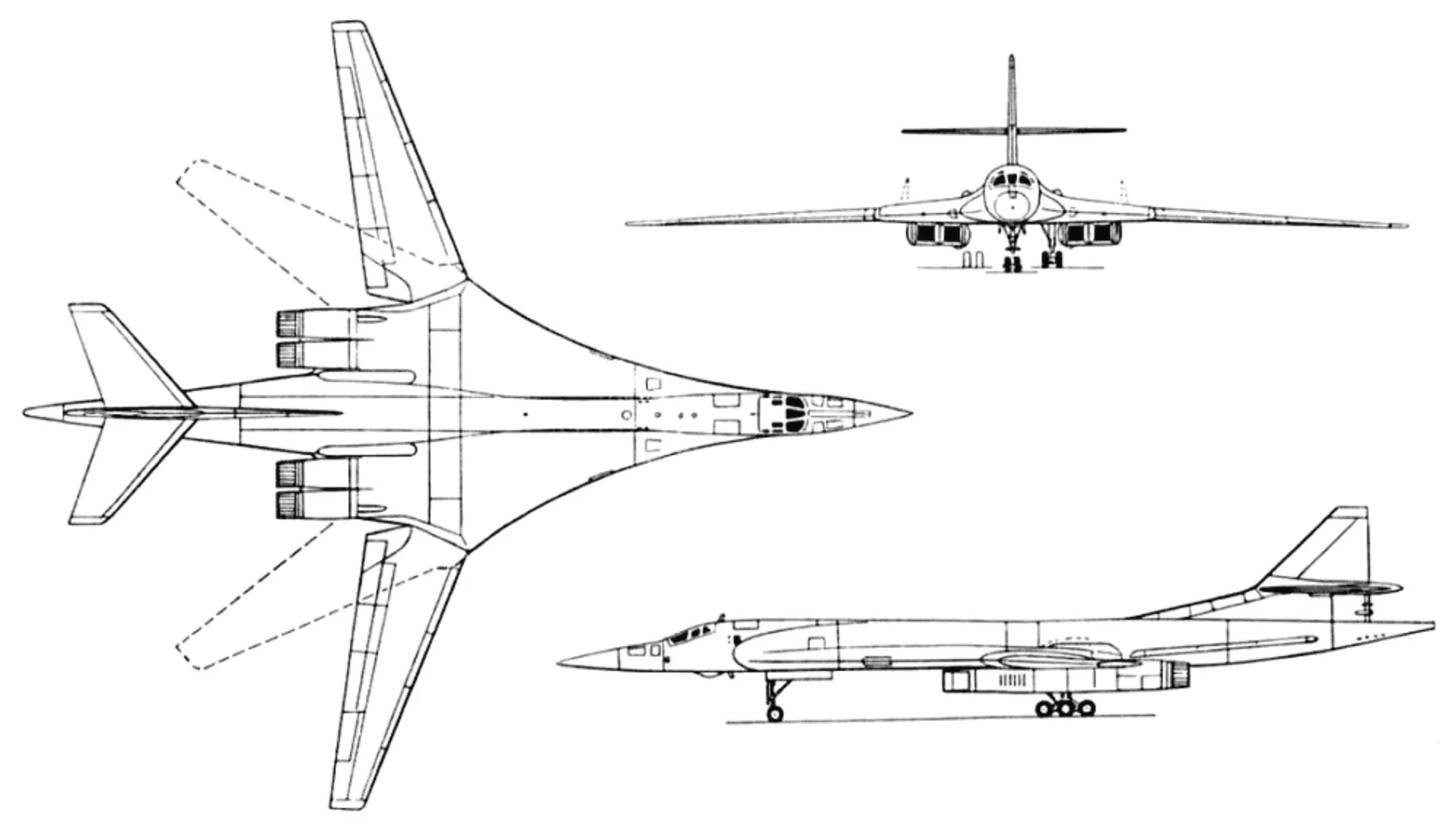
One of the bomber’s key features is its variable geometry wings, which can sweep back from an angle of 20° to 65°. This design allows the aircraft to perform exceptionally well across a wide range of speeds, both supersonic and subsonic.
The tail section, consisting of horizontal and vertical surfaces, is fully integrated and features an all-moving design to improve maneuverability.
The Tupolev Tu-160 Blackjack utilizes advanced fly-by-wire control systems for precise handling. Its landing gear is comprised of a three-strut configuration, complemented by a tail wheel and a brake parachute for additional landing support.
This aircraft is capable of striking strategic targets with both nuclear and conventional armaments, making it highly versatile in continental theatres of operation. For takeoff, it requires a 3,050-meter-long concrete runway, which provides the necessary space for the bomber’s size and weight.
Tu-160 Blackjack Variants
The Tu-160 has several variants, each with unique features and enhancements. These include the Tu-160S, Tu-160V, Tu-160 NK-74, Tu-160M, Tu-160P, Tu-160PP, Tu-160R, and Tu-160SK.
The Tu-160V is a modified version that utilizes liquid hydrogen as its primary fuel source, providing a different propulsion system. On the other hand, the Tu-160 NK-74 is an advanced model equipped with powerful NK-74 engines, enhancing its performance.
The Tu-160M is designed to carry two additional hypersonic Kh-90 missiles, boosting its combat capabilities. The Tu-160P also referred to as the Tu-161, functions as a long-range escort or interceptor aircraft and has been fully modernized to serve as a strategic missile-carrying bomber.
Meanwhile, the Tu-160SK is a specialized commercial variant used primarily for satellite launches as part of the Burlak system. Each model in the Tupolev Tu-160 Blackjack series reflects advancements in technology and design tailored to specific military or commercial purposes.
Tu-160 Cockpit and Avionics
The crew of the Tupolev Tu-160 Blackjack strategic bomber consists of four members: a pilot, co-pilot, navigator, and systems operator. Each crew member is equipped with a zero-zero ejection seat, allowing them to safely eject at any altitude or airspeed, including when the aircraft is stationary on the ground.
Inside the cockpit, all data is displayed on traditional electro-mechanical instruments and screens, rather than on more modern head-up displays or cathode ray tube monitors. This setup is distinct from some other aircraft designs.
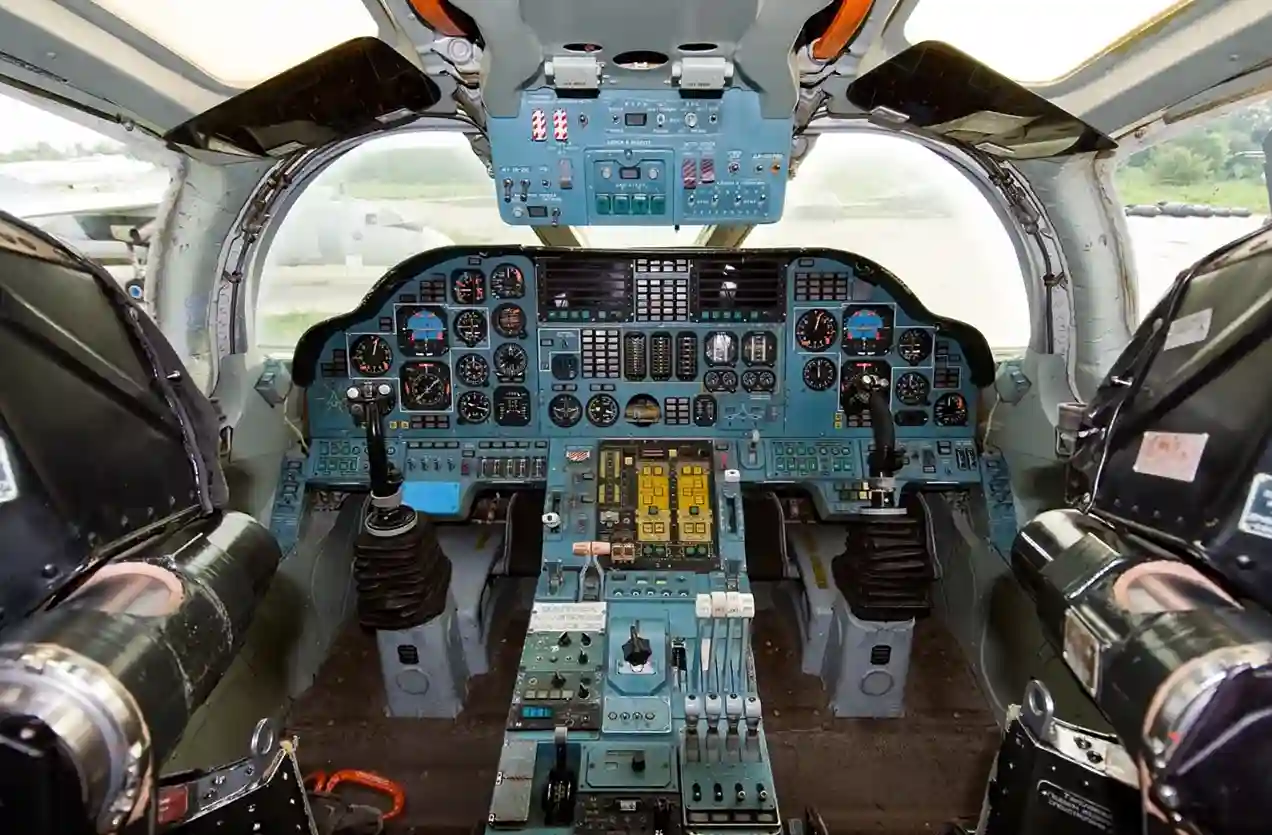
Unlike most large bombers and transport planes that typically feature control wheels or yokes, the Tu-160 uses a control stick for flight operations, similar to those found in fighter jets.
The aircraft is heavily computerized, with advanced avionics that integrate various systems. These include a comprehensive aiming, navigation, and flight control system, alongside a navigation and attack radar, electronic countermeasures, and automated control systems for enhanced functionality.
Tupolev Tu-160 Blackjack Weapons
The Tu-160 is a versatile bomber designed to carry both nuclear and conventional weaponry, including long-range nuclear missiles. These missiles are housed within two weapons bays, each equipped with multi-station launchers.
One of the primary weapons it carries is the Kh-55MS strategic cruise missile, known by its NATO designation AS-15 Kent. The Tupolev Tu-160 Blackjack can accommodate up to 12 of these missiles, with six positioned in each of the two bays.
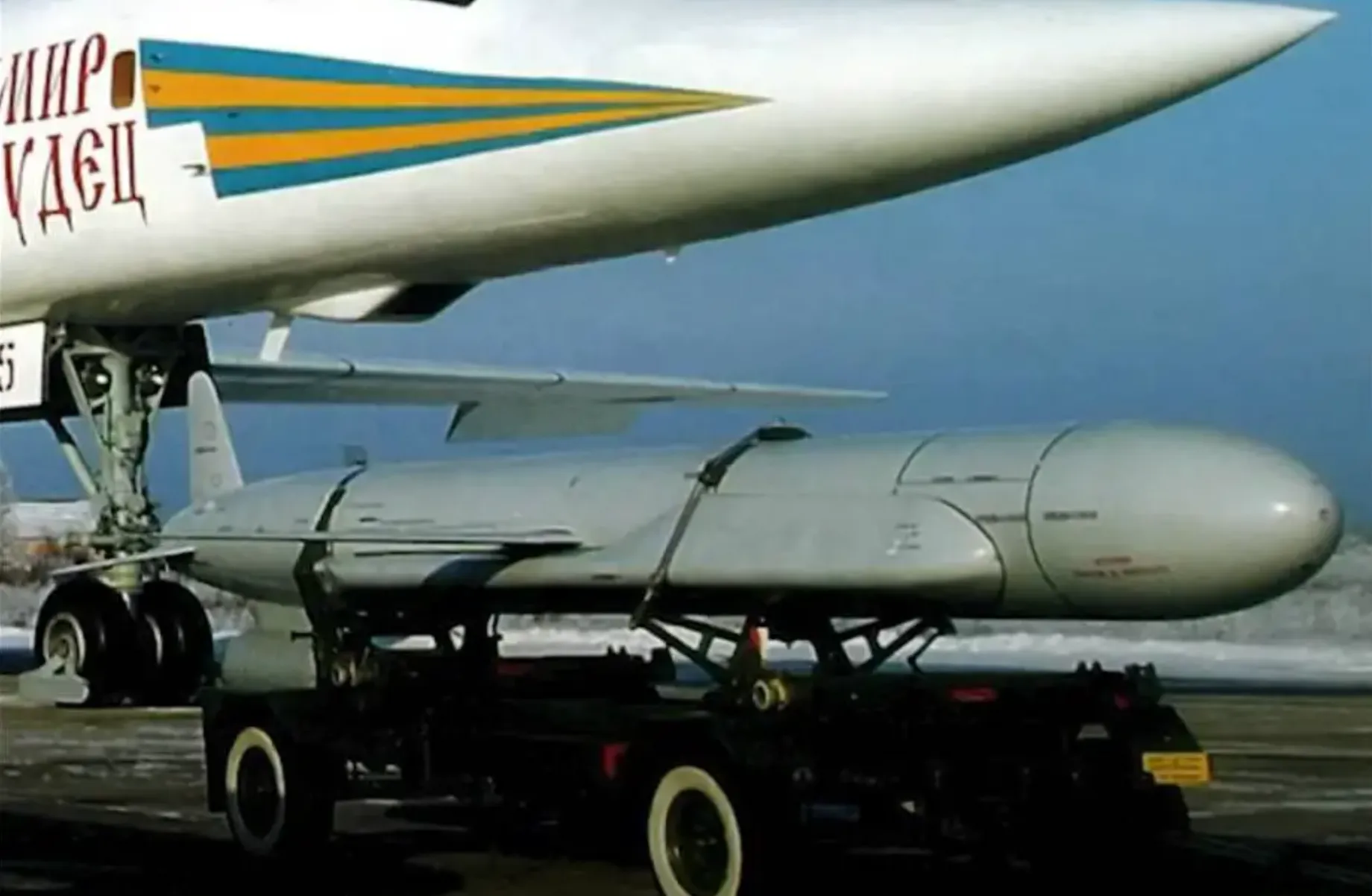
The Kh-55MS uses a turbofan engine for propulsion and has an impressive range of 3,000 kilometers. Each missile is armed with a 200-kiloton nuclear warhead, making it a significant component of the aircraft’s strategic capabilities.
In addition to the Kh-55MS, the weapons bays can also support the Kh-15P missile, which NATO designates as the AS-16 Kickback. The Kh-15P is powered by solid rocket fuel, allowing it to reach targets up to 200 kilometers away. It can be fitted with either a conventional 250-kilogram warhead or a nuclear payload, depending on the mission’s requirements.
Moreover, the Tupolev Tu-160 Blackjack is capable of carrying a variety of aerial bombs, with a maximum payload capacity of up to 40 tons, further enhancing its role as a formidable long-range bomber.
Tupolev Tu-160 Blackjack Engines
The strategic bomber aircraft is equipped with four powerful Samara NK-321 turbofan engines, each capable of delivering up to 25,000 kg of thrust. These engines are housed in twin pods located beneath the wings, allowing for optimal aerodynamics.
The aircraft’s air intake system features an adjustable vertical wedge, ensuring efficient airflow during flight.
One of the bomber’s key features is its in-flight refueling capability. When not in use, the refueling probe is neatly stowed inside the nose section of the fuselage, just ahead of the cockpit. This system, combined with the aircraft’s impressive fuel capacity of 160,000 kg, extends its operational range and mission duration.
The Tupolev Tu-160 Blackjack is built for performance, capable of ascending at a rate of 70 meters per second. It can reach a top speed of 2,220 km/h, with a cruising speed of 960 km/h. Its maximum range is 12,300 km, while its combat radius—meaning the distance it can travel during a mission before returning—is approximately 7,300 km.
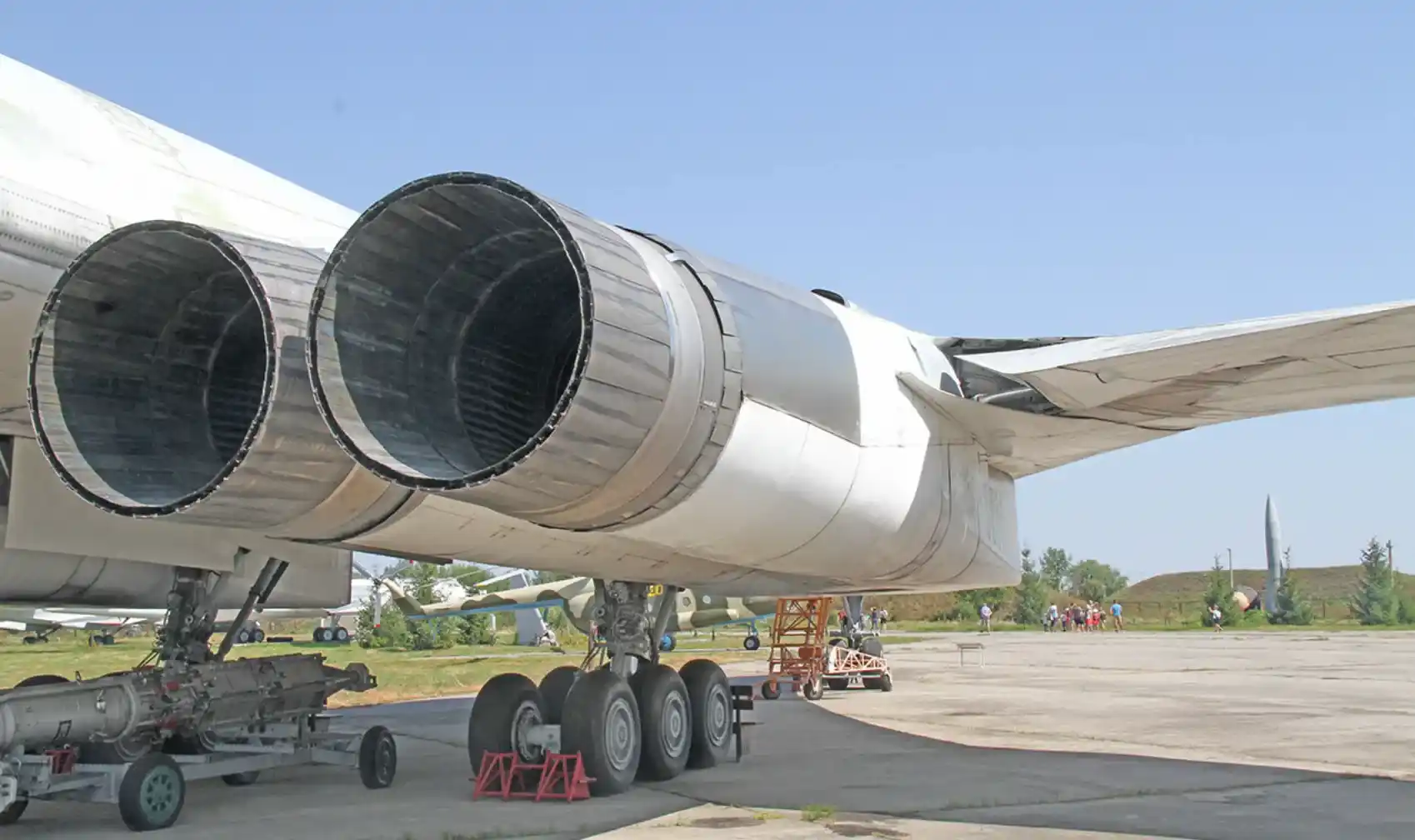
This aircraft boasts a remarkable flight endurance of up to 15 hours, allowing for long-range missions. It can soar at altitudes up to 16,000 meters, giving it a significant advantage in terms of both speed and operational height.
Weighing around 110,000 kg when empty, the Tupolev Tu-160 Blackjack has an enormous maximum take-off weight of 275,000 kg, highlighting its capability to carry a heavy payload while maintaining high performance.
Specifications
In terms of physical dimensions, the Blackjack has a variable wingspan that ranges from 35.6 meters at minimum sweep to 55.7 meters at maximum sweep. Its wing surface area is 232 square meters, while its overall length and height are substantial.
The Tupolev Tu-160 Blackjack has an impressive top speed of 2,200 km/h and can cruise at 1,030 km/h when flying closer to the ground. It operates at altitudes up to 16,000 meters.
The bomber’s empty weight stands at 110,000 kg, while its fuel capacity allows for a fuel load of up to 148,000 kg. Its maximum takeoff weight reaches an astonishing 275,000 kg. Under normal circumstances, the aircraft can carry a payload of 9,000 kg, though it is capable of handling a much larger maximum load. The Tupolev Tu-160 Blackjack has an operational range of 14,000 km with a standard load of 9,000 kg, and 10,500 km with an increased load of up to 40,000 kg.
As for its armament, the Blackjack is equipped to carry either 12 H-55 cruise missiles or 24 H-15 short-range missiles, in addition to free-falling bombs.
Other onboard systems and crew accommodations, as well as specific details on unit costs, development approval, the date of the first flight, the start of series production, the deployment timeline, and current inventory, remain classified or unspecified in this summary.
Share
Defense Feeds
Defense Feeds is publication focusing on informing, engaging, and empowering the world by providing accurate information from defense technology.
Powered by Defense Feeds © 2025 – All rights reserved.




